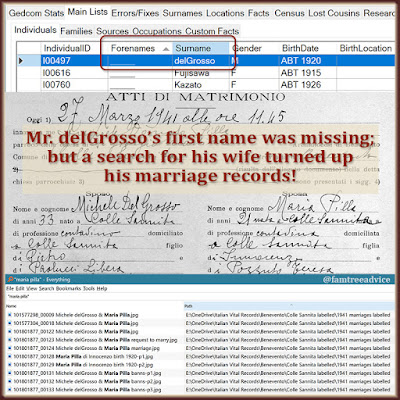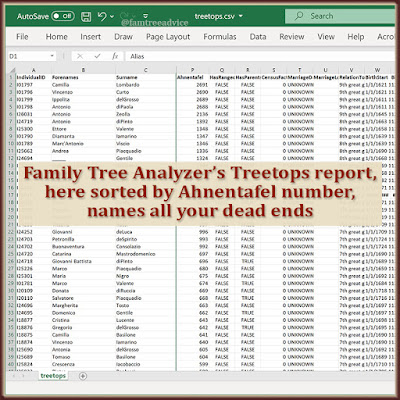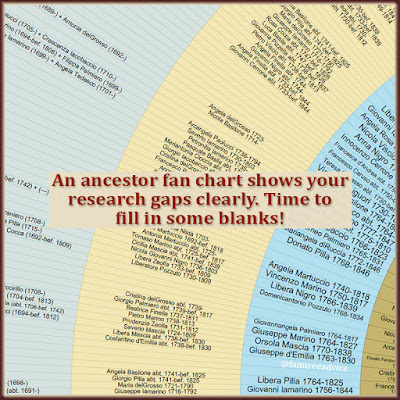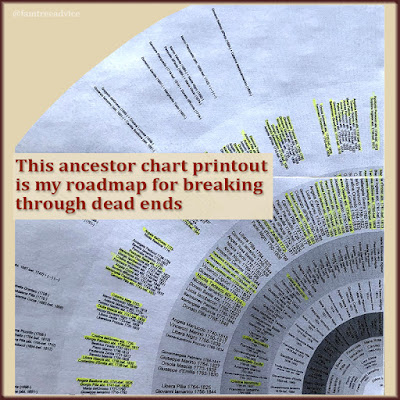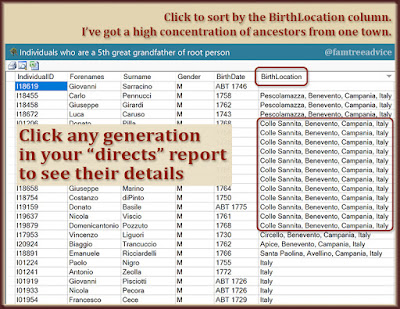I'm living in my 16th home, so I know a thing or two about moving. To lighten the load before you pack, you sort your stuff into three categories: keep, sell, or throw away.
We can use a similar rule on our family trees. I generated a list of unrelated people in my family tree. I fit each person into one of three categories: research, keep, or delete.
This started when a Family Tree Maker user asked how to find the loose (unrelated) people in her family tree. One person answered "Family Tree Analyzer" without an explanation. I launched my copy of the program and answered with these instructions:
Family Tree Analyzer is a free program that can analyze your tree in many ways. Export a GEDCOM from your tree and open it with Family Tree Analyzer. Once it's open, click the Main Lists tab and view the Individuals tab (the first tab). Scroll to the right to find the Relation column and click to sort by it. The "Unknowns" are your loose people.
I did this and exported my full list of people to a spreadsheet. Then I sorted and deleted everyone who did have a relationship to me.
 |
| Take a fresh look at the unrelated people in your family tree. |
Now I had a spreadsheet of all the unrelated people in my family tree. I set out to categorize them as research, keep, or delete. I added a new column to my spreadsheet with the heading "Reason." As I worked my way down the list of alphabetized names, I added the reason they're in my tree.
For example, I had dozens of disconnected people with the last name Asahina. They're in my tree because of an undocumented connection to my husband's Ohama family. In the "Reason" column, I gave each of these people "Asahina" as the reason they're in my tree.
Other people are in my tree because my family says they are cousins, but the documents don't exist. I gave them a last name as a "Reason." They are either Saviano (my great grandmother's maiden name) or Sarracino (my great grandfather's name).
Now that everyone in the list had a particular reason to be there, I sorted the spreadsheet by the reasons.
- Some people were from my grandfather's hometown. I worked with vital records to figure out their connection. I had lots of success and deleted them from the spreadsheet.
- A couple of families were in the published 1742 census for my grandfather's town. I did some research, but I couldn't find a bridge between the civil records and 1742. I decided to keep these 12 people anyway.
- There were a few families of three: two parents and a baby. I searched for more of their children. Unfortunately, all the children died young. Without a marriage to build on, I could not connect this small family to anyone else. I deleted them from my family tree and the spreadsheet.
- When it came to the Asahina family, my own notes for two different people gave me the connection I was seeking. The story is, an Ohama family gave one of their babies to a childless cousin. As shocking as that sounds, it's a Japanese tradition. My own father-in-law was nearly given away! In the Ohama family, I'd entered a baby named _____ Asahina with a note saying, "this is the baby they gave away." In the Asahina family, I had attached a note to a woman named Masa Asahina. "A distant cousin says Masa is the Ohama baby given to the Asahina family." Hurray! I merged _____ Asahina with Masa Asahina, connecting the entire family. I removed them from my spreadsheet of unrelated people.
- I tried again to connect a Saviano clan to myself. The family says they are cousins, and I have no doubt of that. But their hometown didn't keep civil records before 1861. Their church records are lacking, too. I added some new documents and facts, but they are still loose in my tree. I will keep them there.
My family tree still has 161 unrelated people I've chosen to keep. Twelve are from the 1742 census of Grandpa's town. The rest are from the town without documentation. I'm OK with that. They all have a now-documented reason for being in my family tree. I'll be on the lookout to see if any distant cousins know more about them than I do. So far, they don't.
In the end, I researched everyone in the list to some extent, deleted a bunch, and kept 161 people. And that's how you sort out and lighten the load before you move on to more research.
 |
| If you use Family Tree Maker, use these settings to find the unrelated people in your family tree. |
Someone else had a different answer to the "how to find loose people" question. They recommended Family Tree Maker's Kinship Report. With 29,000+ people in my tree, the report takes about 30 minutes to run, and it's 979 pages long. I can export to a spreadsheet by clicking Share, Export to CSV. Then, in Excel, I can filter the results to show only the "Unrelated" Relationship.
I recommend you go with Family Tree Analyzer for quick, useful, effective results. Then get moving and sort out your people.

